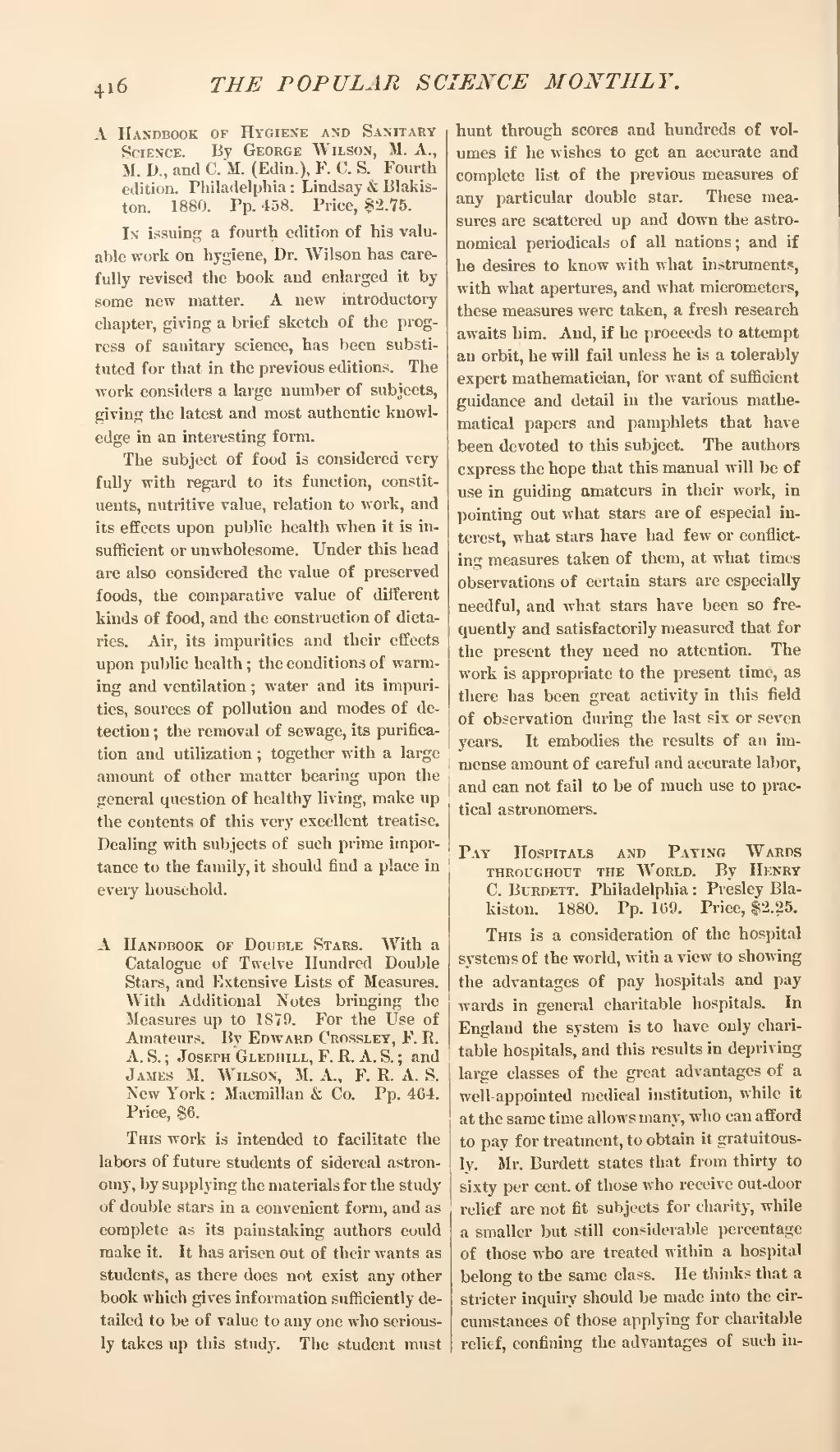A Handbook of Hygiene and Sanitary Science. By George Wilson, M. A., M. D., and C. M. (Edin.), F. C. S. Fourth edition. Philadelphia: Lindsay & Blakiston. 1880. Pp. 458. Price, $2.75.
In issuing a fourth edition of his valuable work on hygiene, Dr. Wilson has carefully revised the book and enlarged it by some new matter. A new introductory chapter, giving a brief sketch of the progress of sanitary science, has been substituted for that in the previous editions. The work considers a large number of subjects, giving the latest and most authentic knowledge in an interesting form.
The subject of food is considered very fully with regard to its function, constituents, nutritive value, relation to work, and its effects upon public health when it is insufficient or unwholesome. Under this head are also considered the value of preserved foods, the comparative value of different kinds of food, and the construction of dietaries. Air, its impurities and their effects upon public health; the conditions of warming and ventilation; water and its impurities, sources of pollution and modes of detection; the removal of sewage, its purification and utilization; together with a large amount of other matter bearing upon the general question of healthy living, make up the contents of this very excellent treatise. Dealing with subjects of such prime importance to the family, it should find a place in every household.
A Handbook of Double Stars. With a Catalogue of Twelve Hundred Double Stars, and Extensive Lists of Measures. With Additional Notes bringing the Measures up to 1879. For the Use of Amateurs. By Edward Crossley, F. R. A. S.; Joseph Gledhill, F. R. A. S.; and James M. Wilson, M. A., F. R. A. S. New York: Macmillan & Co. Pp. 464. Price, $6.
This work is intended to facilitate the labors of future students of sidereal astronomy, by supplying the materials for the study of double stars in a convenient form, and as complete as its painstaking authors could make it. It has arisen out of their wants as students, as there does not exist any other book which gives information sufficiently detailed to be of value to any one who seriously takes up this study. The student must hunt through scores and hundreds of volumes if he wishes to get an accurate and complete list of the previous measures of any particular double star. These measures are scattered up and down the astronomical periodicals of all nations; and if he desires to know with what instruments, with what apertures, and what micrometers, these measures were taken, a fresh research awaits him. And, if he proceeds to attempt an orbit, he will fail unless he is a tolerably expert mathematician, for want of sufficient guidance and detail in the various mathematical papers and pamphlets that have been devoted to this subject. The authors express the hope that this manual will be of use in guiding amateurs in their work, in pointing out what stars are of especial interest, what stars have had few or conflicting measures taken of them, at what times observations of certain stars are especially needful, and what stars have been so frequently and satisfactorily measured that for the present they need no attention. The work is appropriate to the present time, as there has been great activity in this field of observation during the last six or seven years. It embodies the results of an immense amount of careful and accurate labor, and can not fail to be of much use to practical astronomers.
Pay Hospitals and Paying Wards throughout the world. by Henry C. Burdett. Philadelphia: Presley Blakiston. 1880. Pp. 169. Price, $2.25.
This is a consideration of the hospital systems of the world, with a view to showing the advantages of pay hospitals and pay wards in general charitable hospitals. In England the system is to have only charitable hospitals, and this results in depriving large classes of the great advantages of a well-appointed medical institution, while it at the same time allows many, who can afford to pay for treatment, to obtain it gratuitously. Mr. Burdett states that from thirty to sixty per cent, of those who receive out-door relief are not fit subjects for charity, while a smaller but still considerable percentage of those who are treated within a hospital belong to the same class. He thinks that a stricter inquiry should be made into the circumstances of those applying for charitable relief, confining the advantages of such in-
